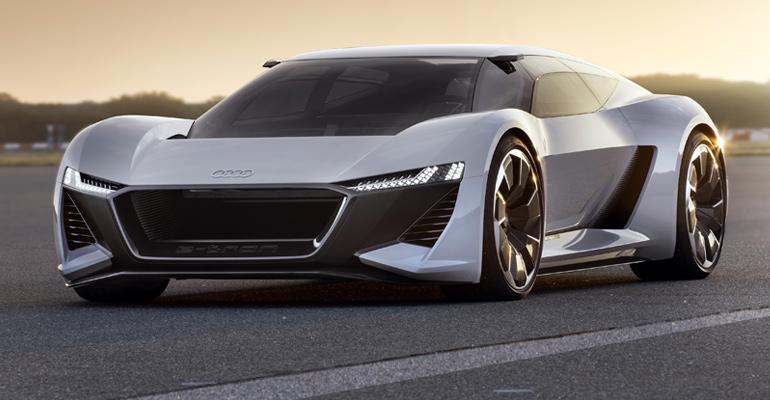Audi previews its plans for a new headlining electric supercar, possibly as a replacement for the existing second-generation R8, with the unveiling of the new PB18 e-Tron concept.
The rakish coupe, revealed at the 2018 Concours d’Elegance in Monterey, CA, and hence the PB18 name, was created in a joint design and engineering program between the newly established Audi Design Loft based in Malibu, CA, and Audi Sport in Neckarsulm, Germany, in what is being billed as a vision for the “high-performance supercar of tomorrow.”
As well as pointing to how Audi envisions its supercar of the future will look, the 764-hp concept also hints at plans by the German automaker to adopt the latest in solid-state battery technology to radically reduce weight and improve the packaging of its upcoming e-Tron models. Together with a body constructed of aluminum, carbon fiber and plastic composite materials, the new all-wheel-drive Audi is claimed to weigh less than 3,417 lbs. (1,550 kg).
The PB18 e-Tron draws on the styling lineage first established on the Audi Aicon concept revealed at the 2017 Frankfurt auto show, albeit with a more dramatic cab-forward silhouette and an extended cockpit that incorporates tapered rear side windows and a large rear window that together hint at the look of a modern-day shooting brake.
Key design elements include a heavily structured front end featuring a bold hexagon-shape grille, sizable air ducts set within the corners, thin laser-beam-touting headlamps and a prominent splitter design to direct air evenly across a flat undertray.
Further back, the PB18 e-Tron receives large front wheel arches, a prominent undercut to the lower section of its doors, ultra-wide sills, window-within-window glasshouse, rearview cameras and cooling ducts within the leading edge of the rear wheels. The wide track stance of the new car is further emphasized by large 22-in. wheels, each featuring eight asymmetrically designed spokes intended to resemble turbine inlets.
The rear is dominated by heavily flared wheel arches, a plunging rear window, adjustable rear spoiler element, full-width light band and a high-mounted diffuser that can be adjusted downward to increase downforce.
Developed under the working title Level Zero, the PB18 e-Tron eschews all the various autonomous driving functions featured on recent Audi concept cars for a more purist approach meant to place the driver in the thick of the action with few comfort-oriented items.
The adoption of full electronic steering, throttle and brake functions contribute to a variable cockpit design (see picture at bottom of story) that allows two different driver’s seat and dashboard positions, either to the left of the interior as in a typical left-hand-drive car or in the center as in a traditional race car.
Audi says the idea for the unique variable cockpit design was inspired in part by the layout of its Le Mans-winning R18 e-Tron quattro LMP1 race car. It lets the driver choose between a center position when driving alone, or a more conventional driving position creating limited space on the interior’s right-hand side for a passenger.
“We want to offer the driver an experience that is otherwise available only in a racing car like the Audi R18,” says Gael Buzyn, head of the Audi Design Loft. “That’s why we developed the interior around the ideal driver’s position in the center. Nevertheless, our aim was to also give the PB18 e-Tron a high degree of everyday usability, not just for the driver, but also for a potential passenger.”
At 178.3 ins. (4,530 mm) in length, 78.7 ins. (2,000 mm) in width and 45.3 ins. (1,150 mm) in height, the new Audi concept is 3.9 ins. (100 mm) longer, 2.3 ins. (60 mm) wider and 3.5 ins. (90 mm) shorter than the R8. The PB18 e-Tron also boasts a wheelbase that is 2.0 ins. (50 mm) longer than Ingolstadt’s flagship supercar at 106.3 ins. (2,700 mm).
The shooting-brake-like rear end design and lack of complex drivetrain hardware result in a trunk offering 16.6 cu.-ft. (470 L) of cargo space. A bespoke luggage set helps make optimum use of the space.
The PB18 e-Tron is powered by three electric motors – one mounted up front within the front axle delivering 201 hp and two units at the rear with 301 hp each.
The combined system output is 671 hp, although a boost function allows the driver to call up 764 hp for brief periods of full-throttle acceleration, giving it an ultimate weight-to-power ratio of 4.5-lbs./hp. Torque peaks at 413 lb.-ft. (560 Nm).
By comparison, the most powerful of Audi’s second-generation R8 models runs a naturally aspirated 5.2L gasoline V-10 delivering 602 hp and 413 lb.-ft. of torque.
The heady reserves combine with all-wheel-drive traction to provide the new Audi concept with a theoretical 0-62 mph (100 km/h) time that Audi describes as “scarcely more than two seconds.” The automaker has not yet quoted a top speed for the PB18, though it does confirm it exceeds 186 mph (300 km/h) and says the driver can vary it according to conditions in a move aimed at extending the range.
Energy for the three motors comes from a liquid cooled solid-state battery with a capacity of 95 kWh. Mounted underneath the trunk at the rear, it is claimed to provide a maximum range of 311 miles (501 km) on the latest European test cycle.
With 800V compatibility, Audi claims the PB18 e-Tron’s battery can be fully recharged in about 15 minutes. It also can be charged cordlessly via induction with Audi’s Wireless Charging system.
Drawing on its motorsport activities, Audi’s latest concept uses a suspension system inspired by its R18 e-Tron quattro LMP1 race car with independent lower and upper transverse control arms, a pushrod system up front and a pull-rod arrangement at the rear, each end fitted with variable magnetic ride dampers.






